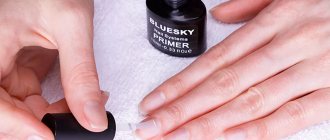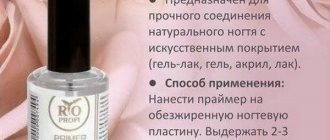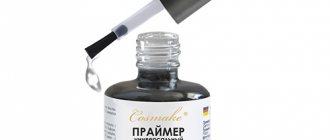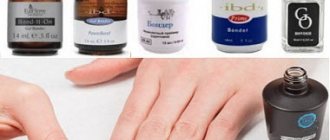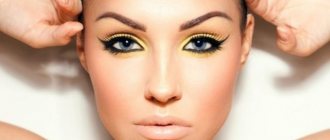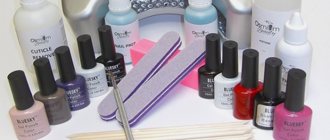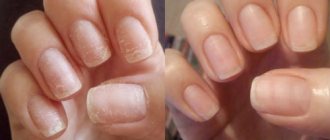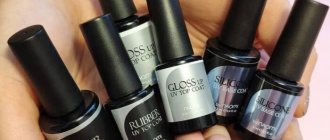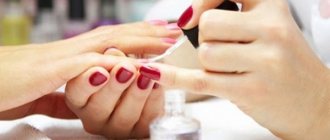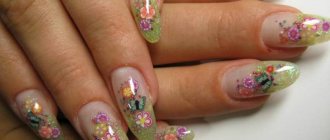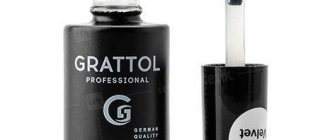What is a nail primer?
Nail primer is the basis for manicure (nail extension). The liquid is often used to strengthen the natural surface when using acrylic or gel materials. Thanks to the proper use of this liquid, the artificial manicure will last much longer and your nails will remain less deformed.
Nail primer (what it is and how to apply it is described below) is a liquid without fragrance or color. Primers are sold in glass bottles with a brush for ease of application. To ensure greater safety of the product, the bottle is made opaque to protect it from sunlight.
Developing companies do not add flavors or dyes to ensure safety for people with hypersensitivity or allergies. The nail fluid dries out very quickly, which can be seen when a white coating appears after treatment. This means that you can continue to work with extensions.
Composition of nail primer
The primer is a transparent liquid that is odorless and has a consistency similar to ordinary water. It is contained in a plastic or glass bottle with a brush, similar to the brush of any varnish. The bottle is most often made opaque to ensure the safety of the product.
The composition of primers differs depending on the manufacturer, but they are usually divided into two large classes: acidic and acid-free. Fragrances and dyes are usually excluded from the composition of products to ensure the safety of people with hypersensitivity and allergy sufferers.
Acid and acid-free primer
The acid primer contains methacrylic acid in a concentration of 30 to 100%. Thanks to it, the scales of the top layer of nails form a strong bond with the material, so this primer is recommended for use when acrylic nail extensions. Acid primer dries out the nail plate greatly, so it is better to use it for oily nails and springboard-shaped nails. When using it, you should be careful not to let the product come into contact with the skin around the nails: this can cause burning and redness. The primer dries very quickly - this is easy to understand by the resulting white coating on the nails, which gives a signal that you can continue working.
An acid-free primer is more gentle and less dangerous for the skin, but is also slightly inferior to an acid primer in terms of the effectiveness of adhesion of the material to the nail plate. This type of primer is recommended for use when applying gel extensions and coating nails with gel polish. It also removes oil from the nails, dries them and removes harmful microorganisms, forming a reliable connection between the scales of the upper layers of the nails and the artificial material.
Primer for gel polish and shellac
To cover nails with gel polish, the use of a primer is not necessary, provided that it stays on the nails for a long time and without chipping. Otherwise, to improve the adhesion of shellac to nails, it is recommended to use any acid-free primer or bonder.
Primer for gel nail extensions
When applying gel nail extensions to tips or forms, it is enough to use any acid-free primer. However, sometimes it needs to be applied 2 times to increase the reliability of the adhesion. Please note that when applying gel extensions to tips, you should avoid getting primer on them: this can lead to cracks. The primer is also applied when correcting nails, but only on the regrown part of the natural nail, avoiding contact with the skin.
Primer for acrylic nails
When extending nails using acrylic powder, it is recommended to use an acid primer as the most reliable in terms of adhesion of the nail surface to the artificial material. It does not affect the color of acrylic and reliably protects it from cracks and peeling, of course, provided it is used correctly.
Why do you need a nail primer?
The primer is widely in demand in professional salons and when doing manicure work yourself.
Depending on the type of work and materials, specialized liquids vary somewhat, but the main tasks for all types are the same:
- guarantees comprehensive protection of the natural nail plate from the appearance of yellow plaque, peeling, and the formation of fungal microflora;
- By avoiding the use of a primer, there is a likely risk of a “greenhouse effect” appearing between the natural and artificial nail plate. This entails the formation of harmful microorganisms under extended nails;
- effective gluing of the extended surface. The durability of the manicure depends on the quality and reliability of the primer;
- functional degreasing of the nail before extensions.
Don't miss the most popular article in the section: How to draw monograms on nails step by step for beginners. Instructions with photos.
Types of nail primer
Today you can buy two main types of primers on the market: acidic and acid-free.
The difference between them is characterized by the final quality of the manicure and appearance:
- A nail primer (what it is and what its purpose is, you can read above) of the acidic variety stimulates the opening of the nail scales, after which it etches the surface of the natural nail, so the artificial surface has better adhesion. This product is very drying to natural nails, so it is best used for oily nails, especially springboard-shaped nails. When using an acid primer, you must be careful to limit its contact with the eyes and mucous membranes. Otherwise, burning and redness will appear.
- The acid-free nail primer works on the principle of “double tape”, thanks to which the natural plate and gel coating have the strongest possible adhesion. The advantage of this liquid is that a special component changes the acidity. This makes the acidity of a natural nail as close as possible to the artificial coating. This is a more gentle product, less dangerous for the skin, but in terms of effectiveness it is used on a par with acidic. The product is best suited for gel extensions. An acid-free primer effectively removes oil from the nail plate, dries it, and prevents fungal infections.
Types of primers
There are several types of primers. They are divided into types depending on what and what shellac primer is needed for:
- Acidic, the peculiarity of which can be determined by its name. This type of primer contains acid (methacrylic). Its content in different primers can vary - 30-100%. Most often, an acid primer is used when extending artificial nails using acrylic technology . The acid composition of the product is more aggressive compared to other types. However, it does the maximum job of what a shellac primer is needed for - it dries the surface of the nail plate, providing the best fixation of the acrylic and the nail plate. In addition, acid primer has the greatest effectiveness in killing fungi and nail infections.
When using an acid primer, at least two layers of the product must be applied to the surface of the nail.
When the primer dries, a whitish coating appears - this means it’s time to proceed to the next stage.
- Acid-free, respectively, a primer that does not contain acid. The main advantage is a more gentle effect on the nail plate, which is an indisputable advantage when choosing a primer. Acid-free primer is suitable for nail extensions using gel technology. An acid-free primer has a lower efficiency in degreasing the plate. The primer also dries the nail plate, while opening the scales, so the gel layer also adheres well to the surface of the nail. The acid-free primer also provides good adhesion to the nail plate.
Ultrabond primer promotes strong adhesion of gel polish to the nail
Although an acid-free primer is less dangerous than an acid primer, it must be applied with caution to avoid contact with the skin.
- Pre-primer (the more common name is bond). This composition is used to cover the nail after polishing, when the nail has been given the desired shape. The bond perfectly degreases and dries the nail plate. A more natural bond-preprimer perfectly degreases and dries the nail plate
Most often, a pre-primer is applied before using acidic or acid-free primers to give the varnish strength and durability.
the bond does not cause allergic reactions, acts delicately on the nail plate without disturbing its structure.
In addition, the pre-primer does not contain fragrance or dye.
What is a primer for gel polish used for?
Depending on the base, each type of primer has its own purpose in combination with gel polish:
- When choosing an acid-free primer, a more stable adhesion of the gel to the surface of the natural nail will be ensured. Thanks to this, there will be fewer chips, cracks and delamination in the future.
- For those who have thin and brittle nail plates, it is better not to use acidic products as a base layer. This will dry out the plate more and worsen its condition.
- You can apply gel polish without primers, as was done before, but the durability of such a coating leaves much to be desired.
Gel polish after long-term use has a negative effect on the nail, and a special product protects and protects the natural plate.
How to use primer
Under gel polish
When applying gel extensions or covering nails with shellac, the plates are treated with a primer.
Process sequence:
- Give the desired shape to your nails.
- Remove cuticles in a convenient way.
- Use a buff (220 grit) to remove the gloss.
- To remove dust and dry the surface, degrease with a conventional compound or a dehydrator.
- Apply the bond over the entire nail or just along the edges.
- When using an acidic composition, drying under a UV lamp (3 minutes) is required.
- Applying the base followed by drying.
- Coating with colored varnish.
- After drying, apply top coat.
Extensions with tips or gel are carried out using any primer that does not contain acid. In order to increase the reliability of adhesion of the layers, it is recommended to apply 2 balls of degreaser.
Work with tips is carried out with care, excluding contact of liquid with workpieces. If the material is handled carelessly, the surface of the artificial nail may become cracked.
Under acrylic nails
The preparation process is performed in the following sequence:
- Push back the cuticle using an orange stick (you can use a pusher).
- Remove shine with a sanding file.
- Apply the bond, first squeezing out excess liquid against the walls of the bottle (do not allow it to come into contact with the skin).
- Allow the layer to dry naturally (when using an acid composition, drying under a UV lamp is required).
- As soon as there is a whitish film on the surface, they begin to build up.
Regular varnish
Under regular varnish, an acid-free composition or a regular degreaser is used. These are products that have a liquid consistency. They are applied with a thin ball without touching the skin. Drying is carried out naturally, it takes about 1-2 minutes. No special lamp needed.
What is a primer for shellac used for?
A nail primer (what it is and why you need it is described above) makes shellac easy to apply, increases its durability and creates a beautiful appearance for your nails.
The use of a special fluid ensures the following:
- degreasing and disinfection of natural nails;
- easy drying;
- protection of the structure of the natural plate;
- increased adhesion.
For shellac, acid-free primers or bonds are most often used.
How to choose a nail primer
When choosing a primer for home use, you need to pay attention to the following characteristics of the product:
1. High level of acids in the primer. It is important to monitor the presence of methacrylic acid in the product. In large quantities it causes burning, redness and can damage the natural nail. Therefore, it is better to use acid primers only in a salon with an experienced technician.
Improper use of acid primers damages nail plates
2. It is better to opt for acid-free primers. In this case, the packaging of the product should be marked “non-acid”. An acid-free primer, penetrating into the layers of the nail plate, forms a sticky coating, due to which the material will adhere better and stronger to the natural nail.
Facial primer: what is it and why is it needed?
A primer is a base that is applied under makeup. After this, decorative cosmetics are already applied to the dermis. His main task is to create an ideal tone, leveling it, masking possible defects, and veiling any imperfections.
This product is sold in liquid or cream form. The primer should hide those problems that ordinary foundation cannot deal with. We are talking about acne, pimples, blackheads, reddish spots, ugly skin tone, wrinkles.
The primer has such a structure that it evens out the surface of the dermis, filling in the smallest folds. All defects become invisible.
In addition, the product has a moisturizing and nutritional effect. It also protects the skin from the negative effects of sunlight. The primer performs another important task: it makes makeup as long as possible.
For what purposes is the primer used?
If we analyze all of the above, the primer should be used to solve the following problems:
- It serves as a link between skin and makeup. It binds cosmetic components, and because of this, makeup becomes durable. This means that a girl (or woman) will not need to apply a lot of foundation. And makeup can be created more natural.
- Make the skin texture even. Using a primer, you can make sure that neither wrinkles nor unevenness of the dermis are visible externally. Pores will visually appear smaller, as well as scars, post-acne and acne.
- To make the skin matte. Due to the presence of active absorbent components in the base, they absorb excess sebum. This fat begins to interact with cosmetics, as a result, its shade changes. And the primer, in contact with sebum, prevents this phenomenon. The cosmetics remain the same color as they were.
- Protect the skin of the face. When a makeup base is applied, a film forms on the skin. As a result, cosmetics cannot penetrate very deeply into the layers of the dermis.
- Smooth the skin. Due to the presence of silicone particles in the base, the light is scattered, and a gentle focus effect is obtained. Externally, the skin appears smoother.
Women value primer because it has an important quality - making wrinkles less noticeable. Possessing a unique composition and special consistency, it evens out the skin texture, filling all the smallest folds. Once the product is applied, no defects will be visible.
How to use nail primer
In order to get the expected result, the primer must be applied according to a special scheme, following the exact sequence:
- Perform a standard hygienic manicure.
- Give the nail plate a beautiful desired shape.
- Using a special buff, orange stick or pumice, carefully remove the cuticle.
- Correct the glossy surface of a natural nail with a gentle nail file.
- Treat the surface with a dehydrator to remove stickiness and grease.
- After this, you can apply the primer by scooping up a small ball of product with a brush and spreading it evenly over the nail plate.
Nail primer degreases and cleans plates, gives stability and evenness to manicure. - Remove excess product with a cotton swab dipped in running water.
- It is better to apply the product in a thin layer, otherwise the possibility of opening the scales on the nail will worsen.
- Wait a minute until the product is completely dry. Often the product simply dries in air; in some cases it requires drying in a UV lamp. In this case, there will be a special mark on the package.
- Apply varnish, gel or top at your discretion.
Don't miss the most popular article in the section: How to extend nails with gel polish. Nail extension instructions for beginners. Photo.
How to apply gel polish primer
A nail primer (you can learn what it is online yourself or consult a nail technician) is an additional fastener between an artificial and natural nail. Thanks to its high adhesion, the primer reliably and firmly holds the gel along the edges of the nail and at the ends (at the most vulnerable places).
The technology for applying primer to gel polish consists of the following points:
- Perform a hygienic manicure.
- Give your nails the desired shape.
- Push back the cuticle with a wooden stick.
- Remove the glossy layer from a natural nail using a 220 grit buff.
- Be sure to degrease the nail using a dehydrator. This will help remove dust, grease, and excess moisture from the surface of the nail.
- Apply primer to the entire nail plate.
- After using base, varnish, gel.
The primer dries almost instantly, compared to analog gel products. The primer manufacturer eliminated the need to dry the coating under a UV lamp. If necessary, a special mark is made on the packaging. Therefore, before you start using, you must carefully study the instructions.
How to apply primer on nails before base coat when
Apply primer to nails before base coat as follows:
- File them to the desired length, desired shape, and treat the surfaces with a buff.
- Remove the keratinized part of the cuticle, clean the sinuses and the plates themselves.
- Brush off sawdust.
- Wipe nails and skin with a cloth moistened with degreaser.
- Dip the brush from the bottle into the primer.
- Get rid of excess liquid by lightly squeezing the fluff against the edge of the container.
- If there is still a lot of product on the brush, you need to touch it with a dry lint-free cloth.
- Apply primer for gel polish to the middle of the plate and allow it to spread slightly.
- Then coat the sides of the nail and the end.
- The product is drawn up again, repeating steps 6-9 with each plate.
- It needs to be allowed to air dry or cured in a lamp, the method depends on the type of product.
- Then the base coat is applied.
It is important to avoid contact of the product with the skin. If this happens, it must be washed off with water.
If you have no experience working with gel polishes, it is better to coat 2-3 nails at a time. The product retains its properties for up to 40 minutes, during which time you need to apply a base to it.
How to dry, how long it takes to dry
The primer should be air dried, that is, just wait until the moisture disappears. This manifests itself externally, no matter what type of product is used. When acid-free, the nails return to the same appearance as before applying the liquid, or shine. And their surface becomes slightly rough. Acidic leaves behind a white coating.
Any product is applied in a thin layer, so the nail primer dries in 60-120 seconds.
It is extremely rare to find products that need to be dried in a lamp. Usually this information is contained in the instructions. If there is no requirement, then the acidic or acid-free primer does not need to be dried in a lamp under any circumstances. This can damage your nails.
Why doesn't it dry on my nails?
If the primer does not dry on your nails, there may be one of three explanations:
- It needs to be polymerized in a lamp. You need to look at the instructions to make sure of this.
- It has residual stickiness. The most likely reason is that the product has dried, but left a layer that will help lay the base more evenly.
- The product was applied too thickly. This means we need to wait a little longer.
How to use for shellac
For shellac, you need to use the product in the same way as when strengthening with gel or coating with gel polish, that is:
- After preparing the nails, wiping with a degreaser.
- With a semi-dry brush, not a drop.
- Apply along the center line of the nail from the base to the free edge, along the sides and end.
- Avoid contact with skin.
- Dry in air until moisture evaporates.
There is only one caveat - you need to take an acid-free product.
How to use an acid-free tack primer
After application to the nail surface, many products leave a sticky layer, due to which improved adhesion is formed. They hold the extension product securely and firmly.
But, experienced professionals note that, in comparison with analogue preparations, these products take a little longer to dry. Therefore, they must be applied in a thin layer to ensure faster drying.
There is no need to try to speed up drying (by blowing on your nails), otherwise air bubbles may form. To do this, you need to take a small amount of product onto the brush. If after a minute after drying the surface is still wet, blot it with a dry cloth.
There is no need to dry acid-free primers under a special lamp, but many manufacturers systematically introduce new products, so it is better to carefully study the instructions and test for an allergic reaction before using the substance. It is accepted that some groups of acid-free primers require drying under a lamp.
How to use primers
Acidic compounds are dangerous in the wrong hands. Let's see how to use an acid primer without harming your nails:
- acid-based primers are contraindicated for peeling, damaged and diseased nail surfaces;
- they cannot be applied in several layers;
- to avoid burns, you should avoid getting acid particles on the cuticle and adjacent soft tissues;
- For the above reason, microcracks and cuts are unacceptable during the trimming stage of manicure.
At home, you should not experiment with acid primer. It is much easier to use an acid-free primer . How does this happen:
- the cuticle is first removed;
- The plate is polished with a sanding file to remove the natural gloss, dust is removed with a brush;
- a very thin layer of primer is evenly applied to the surface;
- the nail is dried naturally or in a UV or LED lamp (indicated in the instructions for the primer);
- the plate is prepared for extension/correction.
When completely dry, acid-free nail primers acquire a transparent texture and become slightly sticky to the touch. “Acid stains” turn white and become dull.
The best acid primers
Top acid primers:
- The most popular and popular brand is Vogue Nails , which, despite its composition, does not have a strong aroma . The primer is applied using the standard method onto a clean, grease-free plate. The product effectively holds the gel polish on the surface of the nails for a long time; corrections can be avoided for more than 30-40 days. But, at the same time, it is worth knowing that Vogue Nails is quite aggressive; after prolonged use, minor damage to the nail plate may occur.
- The affordable NeoNail product is highly effective and strong . Primer "NeoNail" can be purchased for only 250-300 rubles; it prevents peeling and does not injure the nail.
- Inexpensive primer "LianaiL" You can buy it for independent use for only 300 rubles. Numerous reviews confirm high efficiency, durability, and the material does not chip or crack when used.
- A highly effective primer mixture for nails will cost customers only 400 rubles. The primer effectively removes excess moisture, degreases and disinfects the nail. One of the most ideal options.
- Primer "PNB" is an inexpensive but effective product with high performance. The cost is approximately 250-300 rubles. The downsides are the inconvenient bottle and brush, as well as a very strong smell.
The Best Acid-Free Primers
The most popular acid-free primers:
- Popular acid-free primer "Bluesky". The primer effectively holds gel and acrylic material on the nail plate. When using, drying under a lamp is not required. Apply the product in a minimal layer to allow the product to dry better. If after a minute it has not dried, blot the nail plate with a dry cloth. Before treating your nails with decorative material, you should wait until the primer has completely dried. The Bluesky structure has an oil base and does not have a strong aroma. Mainly used before applying base.
- For thorough preparation for a manicure, Luxio is suitable . The primer differs from analogues in its high characteristics, but costs almost 1,300 rubles.
- American-made Cuccio is an effective nail primer . The advantage is an affordable pricing policy, the primer costs 600-650 rubles.
- The liquid from China is quite cheap - only 200-220 rubles. Despite the low price, the product is highly effective, can degrease, disinfect, and effectively adheres to nail surfaces. Disadvantages - an inconvenient brush for application, as well as a strong unpleasant aroma.
- Acid-free primer "Kodi" is at the top of the ranking of top products . Buyers speak well of the composition, reliability, fairly affordable cost, and convenient method of application. The product line of this brand also includes acid primers.
Which acid-free primer to use
Each product is slightly different in composition, consumption, drying speed and duration of action. Therefore, it is worth looking at several brands to understand which one is right for you.
- "Runail" produces liquid in a 15 ml bottle. It is in demand due to its economical consumption and gentle action. During application, the nail is carefully connected to the coating. Before use, the nail must be shaped. The primer dries instantly, and after it you will not be able to work with a nail file. Experts recommend this product for its advantages and minimal number of disadvantages. Even a beginner can master this primer.
- "Kodi" does not damage the cuticle and nails, thanks to its safe composition. It is used for modeling, extensions using gel and acrylic methods. The high price is due to the quality. The liquid is consumed slowly, and, unlike analogues, it can work with gel coatings. were able to achieve this effect without the use of acid.
- Bluesky has an oily consistency and no odor. It is applied before applying the base and dries without a lamp. The bottle has a convenient brush, which allows you to apply the primer without touching the skin. However, additional drying is required; if necessary, wipe the surface with a napkin. This must be done carefully so as not to remove too much layer, otherwise the next applied layer will not last long enough.
- “TNL” is an unsafe product, so it is applied very carefully so as not to cause irritation. They choose it because it performs well under gel and the manicure lasts for more than a month. It dries in about a minute, no need to clean with a napkin. If you are going to do extensions with the application of “TNL”, then carefully remove the coating, since a strong adhesion with a careless approach can form or damage the plate.
These are the main manufacturers whose products have many advantages with a minimum of disadvantages. If primers seem expensive to you, then the market offers a large selection of products with good properties at a low price.
You should choose a primer in professional stores, online stores, and on the official websites of manufacturers. Keep an eye on promotions and fairs, as manufacturers often sell ready-made kits of manicure components, which include everything you need to create a full-fledged nail design. It is also worth finding out the cost not only in your country, but also abroad, on the official website. Sometimes buying directly is much more profitable.
The price of primers ranges from 150 to 2 thousand rubles. This is due to the fact that there are cheap Chinese manufacturers and popular foreign brands on the market. The acid-free option is more profitable to use than the acidic one, since it is cheaper. Before choosing one of the brands, carefully study the composition and look at reviews on the Internet. An aggressive primer with poor durability can be sold at a low price.
Best pre-primers
It is often recommended to use a prep primer before using a classic primer. The advantage of the drug is the fact that there is no negative effect on the structure of the nail plate. Not many people know what a nail primer of the “Bond” variety is. This product is recommended to be used only before the extension material is applied.
The most popular pre-primers include the following types:
- Hong Kong remedy is a universal primer that is used as a primer and can be used as a base coat. The cost of the product is quite affordable - 500 rubles.
- Cheap nail product "inGarden" , which will cost customers only 230 rubles, has fairly high adhesive properties and effectively degreases the surface. The advantage of the product is its safety for the nail plate and the skin around it.
- High-quality YOKO primer has good adhesion properties and demonstrates high-quality adhesion. The price of the product is about 300 rubles.
- EzFlow degreasing liquid does not contain dyes or flavors , therefore it does not cause irritation or an allergic reaction. The primer dries almost instantly, but the cost of the product is quite high - 1000 rubles.
- The “CND” primer is rightfully considered one of the highest quality , but has a high cost - 1150 rubles. It is great for use on weak, thin nails and will provide durable and high-quality extensions. Thanks to the unique formula of the composition, the primer is hypoallergenic and does not cause burning or burning.
Acid-free composition
The liquid has no shade, odor, and the consistency is thin, watery or gel-like. The container in which the primer is stored is colored, as this increases shelf life and protects the composition from sunlight. The product includes the following components:
- Methacrylic acid;
- Ethyl acetate;
- 2-hydroxyethyl matacrylate.
The main component is methacrylic acid, due to which adhesion occurs. But it is precisely this that has an aggressive effect on the nail. Acid-free liquids were the first to be invented, and then a more effective acid primer appeared. However, it is not suitable for all plates. Weakened nails will not withstand acid and will become brittle and rough.
Therefore, an acid-free primer is a coating option that is gentle, does not bleed into the record, and prevents dehydration. Moreover, it contains a solvent, without which there can be no adhesive effect. However, such a remedy poses less of a risk of burns or inflammation.
If your nails are healthy, strong, and have no defects, then use a liquid with acid - it will keep your manicure longer.
How to distinguish a nail primer from a base?
The problem of how to distinguish a primer from a nail base worries mainly newcomers to the nail industry. This question may arise due to the fact that the functions of these two products are quite similar; they provide adhesion to the surface of the natural nail and the applied substance. It is worth understanding that the primer is not a separate layer.
This is just an impregnation liquid that does not dry in a lamp.
The base consists of a three-component coating layer, a sticky top layer, gloss and a layer that cures under the rays of a UV lamp.
A primer must be used, and a nail base is recommended to be used only when you plan to apply single-phase gel polishes for coating. Otherwise, the result of the extension may not be so durable.
Features of working with a primer
As mentioned above, not all products are safe for skin and nails, so we recommend taking into account the basic rules of operation. This will be especially true for those who plan to use it at home.
Many beginners don't know that you don't need to use a special lamp for primer. It air dries quite quickly. However, under no circumstances should it be used in small rooms with poor ventilation. The consequences can be very serious, so do not risk your health.
Before applying the primer, the surface of the nails must be prepared. That is, treat it with a special buff that helps remove unevenness. Also, at home, you should not apply more than one layer of the product. Of course, an experienced master sometimes uses two layers, but this is done in exceptional cases.
Please note that the primer must be dry before you apply any of the possible coating options. Otherwise, a beautiful manicure will definitely not work.
As you can see, a primer is a really necessary tool for creating a stylish manicure with gel polish, as well as for extensions. But you should still follow some rules so as not to harm your health. Especially when using an acidic substance.
What type of nail primer do you use? Share your experience in the comments.
Primer replacement
If it is not possible to use a primer, its corresponding analogues are quite suitable:
- Less aggressive pre-primer or bond. This is a more gentle preparation that does not have a negative effect on the natural plate.
- If you don’t have special products on hand, you can use simple cologne or perfume, which will also effectively degrease your nails.
- A standard liquid or acetone will help remove dust and grease from the natural nail plate.
- Food vinegar will cope with degreasing and disinfection before applying extension material.
- Boric acid is a worthy alternative to primer.
It is important to know! Products containing oils should not be used as a replacement for primer.
In order for the extension to work out as intended, you must strictly follow the advice and consult with an experienced nail technician in advance about what a nail primer is and how to use it correctly. Experienced experts recommend choosing a primer that does not require special drying under a lamp. This will help reduce labor intensity and work time.
Article design: Olga Pankevich
Varieties
Today there are several types of primers. Each of them differs in quality, composition and mechanism of action on the nail plate. Some of them are used only for nail extensions, others to prepare the surface for further painting. Masters use three main options:
- Pre-primer.
- Acid based composition.
- No acid.
The best composition that protects nails is a primer or bond. It is applied to the surface before the nails are covered with acidic and other types of gels. The acid primer thoroughly dries the nail plates and degreases them. The use of an acid composition is necessary to ensure reliable adhesion of the gel polish to the nail. It is especially important to use an acid bond when doing extensions. After the nails are covered with an acidic composition, the small scales of the plate rise, which helps strengthen the gel coating on the nails.
When applying gel nails, it is recommended to use an acid-free primer. It provides a rough surface of the nails, thanks to which the extended nail is held on the natural plate better.
About price and substitutes
Shellac nail primer is not cheap. The price for this composition ranges from two to ten dollars. The wide price range is explained by the different quality of the product. Accordingly, the highest quality composition, which does not harm the nail plates at all, is sold at a high price. Some newbies in the manicure business are wondering what a shellac primer is for and whether it can be replaced with another composition? Primer for shellac is necessary for high-quality adhesion of the gel to the surface of the nail. This product has a unique composition that does not harm the nail plates. Considering this factor, it is impossible to replace the primer with other degreasers. Because there is no similar composition that does not harm the nail surface.
